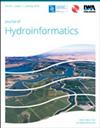水质应急监测网络:基于香农熵的非关键变量识别方法
IF 2.2
3区 工程技术
Q3 COMPUTER SCIENCE, INTERDISCIPLINARY APPLICATIONS
引用次数: 0
摘要
在发生涉及水资源的环境灾难时,部署应急监测网络以评估水质是首先要采取的措施。应急网络通常覆盖流域内的大量水质变量和监测站点。将重点放在对环境危害较大、空间和时间分布较难预测的变量上,是优化监测工作的一种策略。本研究的目的是评估香农熵的使用情况,以确定在受采矿铁尾矿坝溃坝影响的多塞河流域(巴西)实施的应急监测网络中的非关键水质变量。通过聚类分析将监测站划分为水质子区域,并使用香农熵估算监测变量的信息冗余。根据信息冗余并检查是否符合环境规范后,确定了非关键水质变量。结果表明,非关键变量占监测变量的 32-50%。应急网络管理人员发现,这种方法是提高网络性能的有力工具。不过,应特别注意异常值的存在,因为它可能会使基于香农熵的分析产生偏差。本文章由计算机程序翻译,如有差异,请以英文原文为准。
Water quality emergency monitoring networks: a method for identifying non-critical variables based on Shannon's entropy
In the occurrence of environmental disasters involving water resources, deploying an emergency monitoring network for assessing water quality is within the first measures to be taken. Emergency networks usually cover a large set of water quality variables and monitoring stations along the watershed. Focusing on variables that represent greater risk to the environment and have less predictable spatial and temporal distribution is a strategy to optimize efforts on monitoring. The goal of this study is to assess the use of Shannon's entropy to identify non-critical water quality variables in an emergency monitoring network implemented in a watershed impacted by the collapse of a mining iron tailing dam, the Doce River watershed (Brazil). Monitoring stations were grouped into water quality subregions through cluster analysis and Shannon's entropy was used to estimate information redundancy of monitored variables. From information redundancy and after checking for compliance with environment normative, non-critical water quality variables were identified. Results indicated that non-critical variables represent 32–50% of the variables monitored. Emergency network managers find in this method a robust tool to improve the network performance. However, special attention should be paid to outliers' presence that can bias analyses based on Shannon's entropy.
求助全文
通过发布文献求助,成功后即可免费获取论文全文。
去求助
来源期刊

Journal of Hydroinformatics
工程技术-工程:土木
CiteScore
4.80
自引率
3.70%
发文量
59
审稿时长
3 months
期刊介绍:
Journal of Hydroinformatics is a peer-reviewed journal devoted to the application of information technology in the widest sense to problems of the aquatic environment. It promotes Hydroinformatics as a cross-disciplinary field of study, combining technological, human-sociological and more general environmental interests, including an ethical perspective.
 求助内容:
求助内容: 应助结果提醒方式:
应助结果提醒方式:


